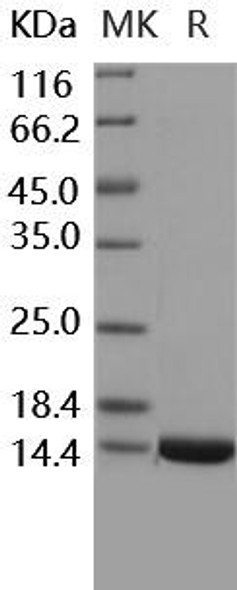Description
| Product Name: | Mouse TXN Recombinant Protein |
| Product Code: | RPPB5048 |
| Size: | 10µg |
| Species: | Mouse |
| Target: | TXN |
| Synonyms: | TRX1, TRX2, Thioredoxin-1, Thioredoxin I, TR-I, Thioredoxin-2, Thioredoxin-1, ADF, Surface associated sulphydryl protein, TXN protein, ATL derived factor, DKFZp686B1993, MGC61975, SASP, Thioredoxin, TRDX, TRX, TRX 1, TXN. |
| Source: | Escherichia Coli |
| Physical Appearance: | Sterile filtered colorless solution. |
| Formulation: | TXN protein solution (1mg/ml) containing Phosphate Buffered Saline (pH 7.4) and 10% glycerol. |
| Stability: | Store at 4°C if entire vial will be used within 2-4 weeks. Store, frozen at -20°C for longer periods of time. For long term storage it is recommended to add a carrier protein (0.1% HSA or BSA).�Avoid multiple freeze-thaw cycles. |
| Purity: | Greater than 90.0% as determined by SDS-PAGE. |
| Amino Acid Sequence: | MGSSHHHHHH SSGLVPRGSH MGSMVKLIES KEAFQEALAA AGDKLVVVDF SATWCGPCKM IKPFFHSLCD KYSNVVFLEV DVDDCQDVAA DCEVKCMPTF QFYKKGQKVG EFSGANKEKL EASITEYA |
| Biological Activity: | Specific activity is >60 A650/cm/min/mg, obtained by measuring the increase of insulin precipitation in absorbance at 650 nm resulting from the reduction of insulin. |
Thioredoxin or TRX contains a single disulfide active site and serves as a general protein disulphide oxidoreductase.Thioredoxins are small disulphide-containing redox proteins (within the conserved Cys-Gly-Pro-Cys active site) that are found in all the kingdoms of living organisms. The proteinis involved in the first unique step in DNA synthesis; It interacts with a wide range of proteins by a redox mechanism based on reversible oxidation of two cysteine thiol groups to a disulphide, along with the transfer of two electrons and two protons. The net result is the covalent interconversion of a disulphide and a dithiol. It has been suggested that thioredoxin may catalyze the formation of correct disulfides during protein folding because of its ability to act as an efficient oxidoreductant.
TXN Mouse �Recombinant produced in E.Coli is a single, non-glycosylated polypeptide chain containing 128 amino acids (1-105 a.a.) and having a molecular mass of 14.1kDa. TXN�is fused to a 23 amino acid His-tag at N-terminus & purified by proprietary chromatographic techniques.
| UniProt Protein Function: | TXN: Participates in various redox reactions through the reversible oxidation of its active center dithiol to a disulfide and catalyzes dithiol-disulfide exchange reactions. Plays a role in the reversible S-nitrosylation of cysteine residues in target proteins, and thereby contributes to the response to intracellular nitric oxide. Nitrosylates the active site Cys of CASP3 in response to nitric oxide (NO), and thereby inhibits caspase-3 activity. Induces the FOS/JUN AP-1 DNA-binding activity in ionizing radiation (IR) cells through its oxidation/reduction status and stimulates AP-1 transcriptional activity. Homodimer; disulfide-linked. Interacts with TXNIP through the redox-active site. Interacts with MAP3K5 and CASP3. In case of infection, interacts with S.typhimurium protein slrP. Interacts with APEX1; the interaction stimulates the FOS/JUN AP-1 DNA- binding activity in a redox-dependent manner. Up-regulated by ionizing radiation. Belongs to the thioredoxin family. |
| UniProt Protein Details: | Protein type:Nuclear receptor co-regulator Cellular Component: mitochondrion; cell soma; axon; dendrite; cytoplasm; extracellular region; nucleus; cytosol Molecular Function:protein binding; enzyme binding; protein disulfide oxidoreductase activity; peptide disulfide oxidoreductase activity; oxidoreductase activity, acting on sulfur group of donors, disulfide as acceptor Biological Process: response to radiation; sulfate assimilation; negative regulation of protein export from nucleus; transcription, DNA-dependent; regulation of transcription, DNA-dependent; protein folding; transport; cell redox homeostasis; regulation of protein import into nucleus, translocation; negative regulation of transcription from RNA polymerase II promoter; positive regulation of peptidyl-serine phosphorylation; glycerol ether metabolic process; positive regulation of DNA binding |
| UniProt Code: | P10639 |
| NCBI GenInfo Identifier: | 6755911 |
| NCBI Gene ID: | 22166 |
| NCBI Accession: | NP_035790.1 |
| UniProt Secondary Accession: | P10639,Q52KC4, Q9D8R0, |
| UniProt Related Accession: | P10639 |
| Molecular Weight: | 11,675 Da |
| NCBI Full Name: | thioredoxin |
| NCBI Synonym Full Names: | thioredoxin 1 |
| NCBI Official Symbol: | Txn1�� |
| NCBI Official Synonym Symbols: | ADF; Txn; Trx1; AW550880�� |
| NCBI Protein Information: | thioredoxin; trx; ATL-derived factor |
| UniProt Protein Name: | Thioredoxin |
| UniProt Synonym Protein Names: | ATL-derived factor |
| Protein Family: | Thioredoxin |
| UniProt Gene Name: | Txn�� |
| UniProt Entry Name: | THIO_MOUSE |






